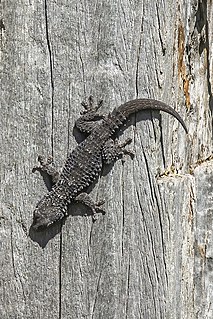
Tarentola is a genus of geckos, commonly known as wall geckos.

Geckolepis is a genus of geckos, commonly referred to as fish scale geckos, which are endemic to Madagascar and the Comoro Islands. They are nocturnal, arboreal, insectivorous lizards, found in primary and secondary forest, as well as degraded habitats. They are best known for their ability to lose their skin and scales when grasped by a predator.

Tarentola mauritanica, known as the common wall gecko, is a species of gecko (Gekkota) native to the western Mediterranean area of North Africa and Europe. It has been introduced to Madeira and Balearic Islands, and the Americas. A nocturnal animal with a predominantly insectivorous diet, it is commonly observed on walls in urban environments in warm coastal areas; it can be found further inland, especially in Spain where it has a tradition of cohabitation with humans as an insect hunter. A robust species, up to 15 centimetres (5.9 in) long, its tubercules are enlarged and give the species a spiny armoured appearance.

Maylandia estherae is a haplochromine cichlid. It is a rock dwelling fish or mbuna from Lake Malawi. This fish, like most cichlids from Lake Malawi, is a mouthbrooder - females hold their fertilized eggs then fry in their mouths until they are released after about 21 days.

The helmethead gecko, also known commonly as the helmeted gecko, is a species of lizard in the family Phyllodactylidae. The species is native to the northwestern coast of Africa, where it is present in Mauritania, Morocco, and Western Sahara. The environment in which this gecko lives is sandy and rocky desert with sparse vegetation, in a zone near the coast where the humidity is high.

The European leaf-toed gecko is a species of lizard in the family Sphaerodactylidae. It is found in coastal regions of France, Italy and Tunisia and on Mediterranean islands. Its natural habitats are rocky areas and rocky shores.

The East Canary gecko or Canary wall gecko is a species of lizard in the family Phyllodactylidae. It is endemic to the eastern Canary Islands. Its natural habitats are temperate shrubland, Mediterranean-type shrubby vegetation, rocky areas, rocky shores, sandy shores, intertidal marshes, arable land, pastureland, plantations, rural gardens, and urban areas.

The Tenerife gecko, also known commonly as Delalande's gecko and the Tenerife wall gecko, is a species of lizard in the family Phyllodactylidae.

The Gomero wall gecko or La Gomera gecko, also known as perenquén in the Canary Islands, is a species of lizard in the family Phyllodactylidae. It is endemic to La Gomera.
The Boa Vista wall gecko is a species of geckos in the family Phyllodactylidae. The species is endemic to Cape Verde, where it occurs on the island of Boa Vista. The specific name boavistensis refers to the type locality.
Cape Verde wall gecko, also Santo Antão wall gecko, is a species of geckos in the family Phyllodactylidae. The species is endemic to Cape Verde, where it occurs in the island of Santo Antão. The species was named by Hans Hermann Schleich in 1984. The specific name caboverdiana refers to Cape Verde, the type locality.
Darwin's wall gecko is a species of lizard in the family Phyllodactylidae. The species is endemic to Cape Verde, where it occurs on the islands of São Nicolau, Sal, Santiago, and Fogo.
Tarentola rudis is a species of geckos in the family Phyllodactylidae. The species is endemic to Cape Verde, where it occurs in the southern part of the island of Santiago and on the Ilhéu de Santa Maria. The species was described as a variety of Tarentola delalandii by George Albert Boulenger in 1906 based on several specimens collected by Leonardo Fea.
Tarentola protogigas is a species of geckos in the family Phyllodactylidae. The species is endemic to Cape Verde, where it is found on the islands Fogo, Brava and the smaller Ilhéus Secos The species was named by Ulrich Joger in 1984.

The giant wall gecko is a species of gecko in the family Phyllodactylidae. The species is endemic to Cape Verde, where it occurs on the island of São Nicolau and on the nearby islets of Branco and Raso. The species was named by José Vicente Barbosa du Bocage in 1875.
Crombie's wall gecko, also known commonly as the Oriente tuberculate gecko, is a species of lizard in the family Phyllodactylidae. The species is endemic to Cuba.
Geckobia is a genus of parasitic mites in the family Pterygosomatidae.









